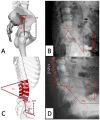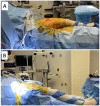Robotic-assisted Total Hip Arthroplasty and Spinopelvic Parameters: A Review
- PMID: 38825818
- PMCID: PMC11162869
- DOI: 10.5371/hp.2024.36.2.87
Robotic-assisted Total Hip Arthroplasty and Spinopelvic Parameters: A Review
Abstract
Total hip arthroplasty (THA) is an effective treatment for osteoarthritis, and the popularity of the direct anterior approach has increased due to more rapid recovery and increased stability. Instability, commonly caused by component malposition, remains a significant concern. The dynamic relationship between the pelvis and lumbar spine, deemed spinopelvic motion, is considered an important factor in stability. Various parameters are used in evaluating spinopelvic motion. Understanding spinopelvic motion is critical, and executing a precise plan for positioning the implant can be difficult with manual instrumentation. Robotic and/or navigation systems have been developed in the effort to enhance THA outcomes and for implementing spinopelvic parameters. These systems can be classified into three categories: X-ray/fluoroscopy-based, imageless, and computed tomography (CT)-based. Each system has advantages and limitations. When using CT-based systems, preoperative CT scans are used to assist with preoperative planning and intraoperative execution, providing feedback on implant position and restoration of hip biomechanics within a functional safe zone developed according to each patient's specific spinopelvic parameters. Several studies have demonstrated the accuracy and reproducibility of robotic systems with regard to implant positioning and leg length discrepancy. Some studies have reported better radiographic and clinical outcomes with use of robotic-assisted THA. However, clinical outcomes comparable to those for manual THA have also been reported. Robotic systems offer advantages in terms of accuracy, precision, and potentially reduced rates of dislocation. Additional research, including conduct of randomized controlled trials, will be required in order to evaluate the long-term outcomes and cost-effectiveness of robotic-assisted THA.
Keywords: Osteoarthritis; Robotic-assisted surgery; Spinopelvic parameters; Total hip arthroplasty.
Conflict of interest statement
One of the authors (H.H.L.) has a potential or pertinent conflict of interest and reports a consultancy with Stryker. No other potential conflict of interest relevant to this article was reported.
Figures





Similar articles
-
Robotic-Assisted Total Hip Arthroplasty Through the Posterior Approach.JBJS Essent Surg Tech. 2025 Mar 18;15(1):e24.00010. doi: 10.2106/JBJS.ST.24.00010. eCollection 2025 Jan-Mar. JBJS Essent Surg Tech. 2025. PMID: 40104527 Free PMC article.
-
Intraoperative Technology Use Improves Accuracy of Functional Safe Zone Targeting in Total Hip Arthroplasty.J Arthroplasty. 2022 Jul;37(7S):S540-S545. doi: 10.1016/j.arth.2022.02.038. Epub 2022 Feb 18. J Arthroplasty. 2022. PMID: 35428540
-
Computerised tomography-based planning with conventional total hip arthroplasty versus robotic-arm assisted total hip arthroplasty: study protocol for a prospective randomised controlled trial.Trials. 2020 Sep 10;21(1):776. doi: 10.1186/s13063-020-04702-7. Trials. 2020. PMID: 32912292 Free PMC article.
-
Acetabular cup positioning in primary routine total hip arthroplasty-a review of current concepts and technologies.Arthroplasty. 2023 Dec 1;5(1):59. doi: 10.1186/s42836-023-00213-3. Arthroplasty. 2023. PMID: 38037156 Free PMC article. Review.
-
Computer-assisted orthopaedic surgery and robotic surgery in total hip arthroplasty.Clin Orthop Surg. 2013 Mar;5(1):1-9. doi: 10.4055/cios.2013.5.1.1. Epub 2013 Feb 20. Clin Orthop Surg. 2013. PMID: 23467021 Free PMC article. Review.
Cited by
-
Robot-assisted percutaneous cannulated screw fixation in the treatment of slipped capital femoral epiphysis.J Child Orthop. 2025 Feb 14;19(2):158-165. doi: 10.1177/18632521251319987. eCollection 2025 Apr. J Child Orthop. 2025. PMID: 39959673 Free PMC article.
-
Robotic-Assisted Total Hip Arthroplasty Through the Posterior Approach.JBJS Essent Surg Tech. 2025 Mar 18;15(1):e24.00010. doi: 10.2106/JBJS.ST.24.00010. eCollection 2025 Jan-Mar. JBJS Essent Surg Tech. 2025. PMID: 40104527 Free PMC article.
References
-
- Nilsdotter AK, Lohmander LS, Klässbo M, Roos EM. Hip disability and osteoarthritis outcome score (HOOS)--validity and responsiveness in total hip replacement. BMC Musculoskelet Disord. 2003;4:10. doi: 10.1186/1471-2474-4-10. https://doi.org/10.1186/1471-2474-4-10. - DOI - PMC - PubMed
-
- Barrett WP, Turner SE, Leopold JP. Prospective randomized study of direct anterior vs postero-lateral approach for total hip arthroplasty. J Arthroplasty. 2013;28:1634–8. doi: 10.1016/j.arth.2013.01.034. https://doi.org/10.1016/j.arth.2013.01.034. - DOI - PubMed
-
- Sariali E, Leonard P, Mamoudy P. Dislocation after total hip arthroplasty using Hueter anterior approach. J Arthroplasty. 2008;23:266–72. doi: 10.1016/j.arth.2007.04.003. https://doi.org/10.1016/j.arth.2007.04.003. - DOI - PubMed
-
- Siguier T, Siguier M, Brumpt B. Mini-incision anterior approach does not increase dislocation rate: a study of 1037 total hip replacements. Clin Orthop Relat Res. 2004;(426):164–73. doi: 10.1097/01.blo.0000136651.21191.9f. https://doi.org/10.1097/01.blo.0000136651.21191.9f. - DOI - PubMed
-
- Matta JM, Shahrdar C, Ferguson T. Single-incision anterior approach for total hip arthroplasty on an orthopaedic table. Clin Orthop Relat Res. 2005;441:115–24. doi: 10.1097/01.blo.0000194309.70518.cb. https://doi.org/10.1097/01.blo.0000194309.70518.cb. - DOI - PubMed
Publication types
LinkOut - more resources
Full Text Sources

